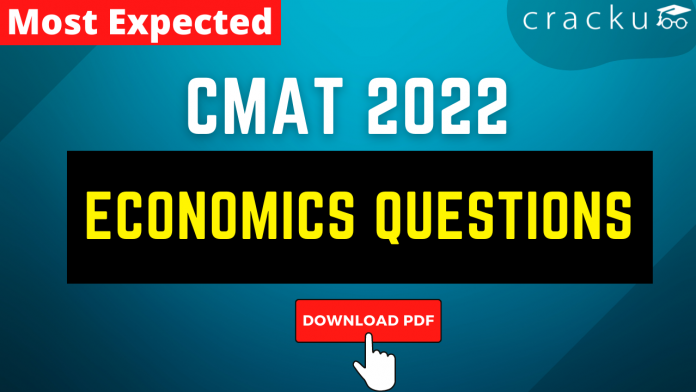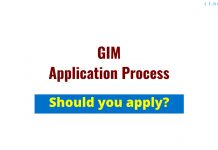Economics Questions for CMAT 2022 – Download PDF
Download CMAT 2022 Economics Questions PDF by Cracku. Very Important Economics Questions for CMAT 2022 based on asked questions in previous exam papers. These questions will help your CMAT preparation. So kindly download the PDF for reference and do more practice.
Download Economics Questions for CMAT
Take CMAT mock tests here
Download CMAT previous papers PDF
Question 1: As per Economic survey 2017-18, the percentage contribution of the Services Sector to
India’s GDP will be in the range of:
a) Between 40-50%
b) Greater than 50%
c) Less than 30%
d) Between 30-40%
Question 2: How much loan amount was sanctioned by The World Bank to help India develop its first modern waterway?
a) $575 million
b) $275 million
c) $375 million
d) $475 million
Question 3: What is Showrooming?
a) An individual browses the sites of e-retailers for products and then ends up purchasing the product from some brick and mortar store.
b) An individual visiting a brick and mortar store to have a look and feel of the product and then ordering the same product through some e-retailers.
c) An individual visiting a big box retailer to have a look and feel of the product and then purchasing the same product from nearby kirana (Mom and Pop) store.
d) An e-retailer using the kirana (Mom and Pop) stores to keep its stock of goods and meets the orders in the nearby localities.
e) None of the above
Question 4: Indian Government is planning to introduce GAAR. What is the purpose of GAAR?
a) Increase rural Income
b) Increase agriculture income
c) Regulatory authority for managingagriculture resources
d) Regulate foreign investment in agriculture
e) Curtail tax avoidance
Question 5: Which of the following was not the reason for the recent slide of Indian Rupee?
a) Huge trade Deficit
b) Low Growth and High Inflation
c) Low Capital Inflow
d) Burgeoning current account deficit
e) High employment rate
Get 5 CMAT mocks at just Rs.299
Download CMAT Previous Papers PDF
Question 6: Which of the following are millennium development goals?
a) Poverty eradication, reducing child mortality, reducing trade barriers, combating AIDS
b) Poverty Reduction, environment sustainability, universal primary education, equal employment
c) Reduce unemployment, promote diversity,combating malaria, improving maternal health
d) Globalization, reduction in poverty, combating AIDS, universal primary education
e) Poverty eradication, improving maternal health, universal primary education, combating AIDS
Question 7: CPI and WPI as acronyms refer to
a) Political Parties
b) Purchasing capacity indices
c) Price Indices
d) Poverty indices
e) Unemployment indices
Question 8: The cost price of an article is x. It is marked up by 120%. It is sold at Rs 8800 after giving 20% discount. What is the value (in Rs) of x?
a) 7680
b) 6000
c) 6680
d) 5000
Question 9: The demand for an inferior good decreases with ________ in the consumer’s income.
a) increase
b) decrease
c) constant
d) double
Question 10: If price of an article decreases from Rs 800 to Rs 700, quantity demanded increases from Q1 units to 70 units. If point elasticity of demand is -1.333 find Q1?
a) 80 units
b) 90 units
c) 60 units
d) 50 units
Question 11: Which of the following will cause an increase in demand for a good?
a) an increase in income if the good is an inferior goods
b) a decrease in the price of the goods
c) a decrease in income if the good is a normal goods
d) an increase in the price of its substitute goods
Question 12: If India exports more than it imports, which of the following is likely to happen?
a) INR is likely to appreciate against other currencies
b) The supply of INR is likely to exceed the demand in the foreign exchange market, ceteris paribus
c) INR would be under pressure to depreciate against other currencies
d) Both B and C are correct
Question 13: Negative inflation is also called:
a) Disinflation
b) Deflation
c) Both
d) None of the above
Question 14: India recently started “Maitree Express” to which of the following destinations ?
a) Islamabad
b) Karachi
c) Dhaka
d) Kathmandu
e) None of these
Question 15: Many times we hear about SEZ in newspapers /magazines. What is the full form of SEZ ?
a) Small Economic Zone
b) Social Economic Zone
c) Special Enforcement Zone
d) Service & Economic Zone
e) Special Economic Zone
Answers & Solutions:
1) Answer (B)
The services sector contributed 55.2% to India’s GVA in 2017-18
2) Answer (C)
The Government of India and the World Bank today signed a $375 million loan agreement to support India develop its first modern inland water transport fairway on the Ganga river between Varanasi and the seaport of Haldia.
Option C is correct.
3) Answer (B)
Showrooming is the process in which an individual visits a showroom to know how a product looks and feels before buying it online at a discount. Therefore, option B is the right answer.
4) Answer (E)
GAAR stands for General anti-avoidance rule. The rule was established under chapter X-A of Income tax act, 1961. The rule was enacted to curtail tax avoidance. Therefore, option E is the right answer.
5) Answer (E)
The 2012 slide in Indian rupee was caused due to a huge trade deficit, low growth and high inflation, low capital inflows and increasing current account deficit. High employment rate was not one of the reasons for the slide of rupee in 2012. Therefore, option E is the right answer.
6) Answer (E)
The UN set 8 development goals in 2000 to be accomplished by 2015. These goals are known as the millennium goals.
The goals are as follows:
1. Eradicate extreme poverty and hunger.
2. Achieve universal primary education.
3. Promote gender equality
4. Reduce child mortality
5. Improve maternal health
6. Combat HIV and Malaria
7. Ensure environmental sustainability
8. Develop global partnerships for development
Only option E captures these points. Therefore, option E is the right answer.
Millennium development goals were replaced by sustainable development goals in 2015.
7) Answer (C)
CPI is the abbreviation of Consumer Price index.
WPI is the abbreviation of Wholesale price index.
CPI and WPI are price indices used to keep track of inflation. Therefore, option C is the right answer.
8) Answer (D)
$\frac{100-20}{100} \times \frac{100+120}{100} \times (x) = 8800$
$\frac{80}{100} \times \frac{220}{100} \times (x) = 8800$
$ x = 8800/(1.76) = 5000$
So the answer is option D.
9) Answer (A)
Increase is the correct word because when people’s income increases, they start looking for superior goods and hence demand for inferior goods decreases.
10) Answer (C)
Point price elasticity of demand = (Change in quantity / Change in price)
-1.33 = $\frac{(70 – Q1) / Q1}{(-100 / 800)}$
560 – 8Q1= 1.33Q1
560 = 9.33Q1
Q1 = 60.02
Hence, option C is the correct answer.
11) Answer (D)
Increasing the price of its substitute goods will increase the demand for a good. While, a decrease in the price of the goods cause an increase in quantity demanded, not an increase in demand.
=> Ans – (D)
12) Answer (A)
If India starts exporting more than it imports, the current account would be in surplus (foreign currencies flowing into the current account, which constitutes all the trades in goods and services, would be more than foreign currencies flowing out).
This may or may not lead to a strengthening of Rupee Vs foreign currencies, depending on how the capital account is behaving, that is, if the foreign currencies in terms of investments, portfolio and direct, are flowing in or out.
However, as a rule of thumb, if the current account is in huge surplus (like say China), our currency should appreciate. Dollars would be cheaper. Also, a positive current account would build in the sentiments of capital and forex markets and more forex would pour in. This might have a domino effect.
In the end, the currency would strengthen (theoretically) to an extent where our exports would be too costly and imports would be cheap, and the balance is restored.
13) Answer (B)
Negative inflation is also called deflation.
Hence, option B is the correct answer.
14) Answer (C)
COMPUTER KNOWLEDGE / MARKETING APTITUDE
15) Answer (E)
COMPUTER KNOWLEDGE / MAKETING APTITUDE





